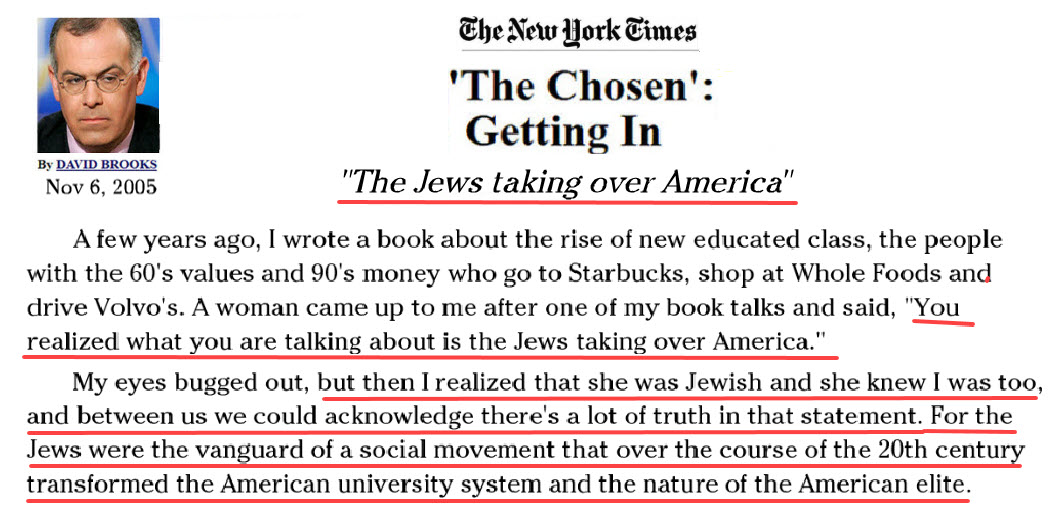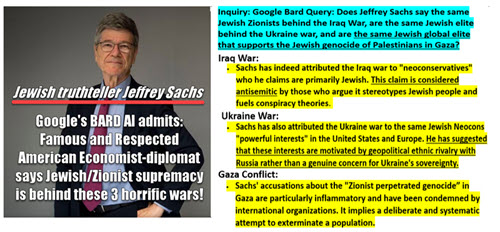 Will Intermarriage End Jewish Ethnocentrism?
Will Intermarriage End Jewish Ethnocentrism?
An excerpt from Dr. David Duke’s My Awakening.
It is often said that the high rates of intermarriage between Jews and Gentiles, especially in the United States, will diminish ethnocentrism and cause assimilation of the Jewish population into the Gentile gene pool. The highly publicized and popularly promoted book The Myth of the Jewish Race by Ralph and Jennifer Patai makes that contention. They suggested that Jewish intermarriage has steadily increased since the Enlightenment.
It is true that many Jewish groups and leaders have raised a great commotion about the dangers of intermarriage. Major Jewish publications often have articles and even ads decrying intermarriage and imploring Jews to marry only other Jews. Steve M. Cohen writes the following in The Jewish Family: Myths and Reality:
Vigorous effort by organized Jewry to try to halt or reverse recent demographic changes … to get large numbers of Jews to change their family-related decisions – that is, to marry young, marry each other, stay married, and have many children.
Pinches Stolper cites the Union of Orthodox Jewish Congregations of America promoting only strong pure Jewish marriages. In describing the threat of a beautiful Gentile girl living just a few houses away, he asserts:
Intermarriage is a tragedy the Jewish people cannot tolerate. The person who marries out of the faith has turned his or her back on the Jewish people. Our tradition regards such a person as spiritually dead, and the family sits shiva [observes a period of mourning] for him or her.
Such marriages rarely work, even when accompanied by a socalled conversion to Judaism, and certainly can never work when the Jewish partner is seriously concerned with his or her Jewishness. For the families involved, the result is heartbreak and tragedy, and for the children, a life of frustration, conflict, and strain.
David Landau shows that Jewish fundamentalism is rapidly increasing in the Diaspora. He quotes one of the opponents of a mild change in Reform law allowing tracing of genealogy through the father rather than the mother as “one of the most evil crimes, almost akin to Hitler. It destroyed the integrity of the Jewish People.”
Rising fundamentalism has also meant a rise in birthrates among the most committed Jews. In an essay in the book The Jewish Family: Myths And Reality, Cohen notes that through high birthrates and by “using insulating mechanisms, the Hasidim have achieved a high degree of success in offsetting the assimilative tendencies of the larger society.”
Therefore, it can be seen that organized Jewry has made a concerted effort to encourage endogamy among Jews. Orthodox groups are certainly the most extremely opposed to intermarriage, but even the newspapers and magazines published by Reform groups strongly discourage it. The Jewish researcher Ellman comments in the journal Jewish Social Studies that the only ethnic or religious community in the United States that continues to attempt to limit and discourage conversions and intermarriage is the organized Jewish community. But Ellman – along with a number of other authors who are strongly opposed to intermarriage – also believe that the seemingly high rates of intermarriage are no real threat to the Jewish heritage. He suggests that it strengthens the traditional Jewish culture and genotype by eliminating those Jews who have assimilationist tendencies.
Ellman points out that intermarriage has little effect on the core of Judaism. He points out that intermarriage is far more frequent for second and subsequent marriages in which the couples are unlikely to have children. He also cites the much higher rates of divorce in intermarriage. More than 90 percent of intermarriages results in nonconversion and thus the intermarried do not become part of the Jewish community. Only a small percentage of children of intermarriage are raised as Jews, and more than 90 percent of them do not marry Jews. Ellman also reports that Jews of higher socioeconomic status are more likely to marry other Jews, thus the community will continue to be dominated by a pure Jewish elite core while lower-class Jews, who do not represent the desired traits of ethnic solidarity, are much more likely to marry outside and leave the community.
Barry Kosmin and other Jewish researchers, in Highlights of the CJF 1990 National Jewish Population Survey, found that 91 percent of intermarriages were made up of nonconversionary couples, that only 28 percent of the children of such couples were raised as Jews, and that even this small minority’s descendants would not be likely to marry Jews.
Not only are intermarried Jews far more prone to leave the Jewish circle, evidence suggests that they often encounter hostility in Jewish society. Jewish authors such as Michael Meyer and C. Waxman cite “tacit rejection” of the mixed couples. All these factors indicate that mixed marriages have little effect on the Jewish gene pool other than affecting the overall number of Jews.
Higher rates of intermarriage will probably have the long-term effect of strengthening traditional Jewish genetic characteristics. Jewish elements prone to assimilation are being removed while at the same time there is a resurgence in Jewish orthodoxy and high birthrate among the most committed of the Jewish elements such as the Hasidim. Additionally, religious Jews in Israel are almost all Orthodox, and there is almost no intermarriage in the world nexus of Jewry — the nation of Israel.
Perhaps the best way to describe the Jewish community is how the distinguished Jewish writer Daniel Elazar does in Community and Polity: Organizational Dynamics in American Jewry. He proposes a model of concentric circles. The inner circle is a hard core of about 5 to 8 percent who lead what he calls “fully Jewish lives.” Next are 10 to 12 percent of Jews whom he calls “participants.” They are often employed in “Jewish civil service,” working tirelessly for Jewish causes. Third, he identifies 25 to 30 percent of Jews whom he calls “contributors and consumers.” These make regular contributions to Jewish causes and make use of the Jewish community for things such as weddings, bar mitzvahs, and funerals. Elazar calls his last group the “peripherals and repudiators.” They make no contributions to Jewish causes, but sometimes the inner circles pull them in to participation or they are peeled off, leaving the Jewish core at the center and the whole of Jewry more committed than ever.
Because of copious publicity of high rates of Jewish intermarriage, some Gentiles may come to believe that Jews are becoming less ethnocentric. But in reality the opposite is true. Those Jews left at the core are less disposed to assimilation. At the same time, the out-marrying Jews who are amenable to Gentile values also serve an important role in causing Gentiles to believe the Jewish group is more similar to them than it actually is.
More importantly, some Jewish researchers see a degree of intermarriage as having a functional value in Gentile environments. Mark Zborowski and Elizabeth Herzog say that it serves as a bridge to the Gentile community, but one that does not threaten the Jewish core.
The peripheral area which serves as a bridge to the surrounding cultures fills several functions. It is an avenue to invasion, a buffer and a source of renewed vigor. Each impact that chips at the outer edge may serve simultaneously to strengthen the core.
Lieberman and Weinfeld, in their article “Demographic Trends and Jewish Survival,” view relatively high levels of intermarriage as a successful strategy in securing greater support from the Gentile comunity for their political and social goals such as political support for Israel.
The successful exercise of influence is best achieved in a community with a large subset of members interacting with politicians and opinion leaders. Through intermarried Jews themselves, and certainly through their social networks involving Jewish family and friends who may be closer to the core of the community, Jewish concerns, interests, and sensibilities can be articulated before a wider, more influential audience. In a recent interview, Presidential aide Robert Lipshutz traced the origin of Jimmy Carter’s concern for Israel to his close friendship with a first cousin, an Orthodox Jew (Carter’s aunt married a Jewish man, and their two children were raised as Jews). Intermarrying Jews, while perhaps diluting the community in one sense, perform compensating strategic functions in another.
Obviously, if intermarried Jews serve as a “bridge to the Gentile community,” those who are outside of the Jewish community but are conscious of Jewish blood will often have warm feelings toward that heritage and be well disposed to Jewish interests. They will also express less solidarity with European issues and interests.
Far from solving the Jewish-Gentile conflict, intermarriage only tends to reinforce the core Jewish genotype and nurture more extreme political and cultural solidarity. By sending their allies into our culture and body politic, they are better able to secure Jewish interests. Among Gentiles intermarriage has the opposite effect. Because they are absorbed almost wholly into our society, our own solidarity is weakened while giving the appearance that the Jewish community is less impenetrable and ethnocentric. There is no real threat to the Jewish genotype; if anything it becomes more “Jewish” each generation.
Once I learned that Jews had a different genetic heritage than Europeans and that this difference was intensifying, I wanted to understand what that could mean in terms of Jewish behavior and evolutionary strategy.
–Dr. David Duke, My Awakening, ch. 25, “Jewish Evolutionary Strategy and Claims of Jewish Superiority.”



